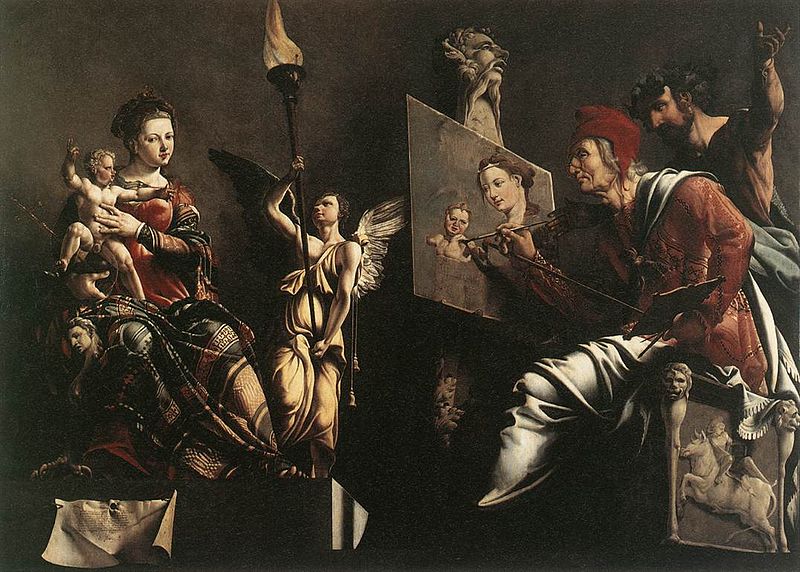* * * *

* * * *
Wednesday, October 18, is the Feast Day for St. Luke. He wrote the third-of-four Gospels, and also wrote the book Acts of the Apostles. (The “fifth book of the New Testament.”) And some scholars have called Luke’s Gospel “the most beautiful book that ever was.”
Luke wrote the longest of the Gospels, and so – with Acts – his two books make up a full quarter of the New Testament. (According to Garry Wills in his What the Gospels Meant. He added that Luke’s two books are longer than all 13 of Paul’s letters.) And Luke’s Gospel is considered the most humane of four gospels. Dante said that Luke was the “scribe of Christ’s gentleness.”
Which we could use a lot more of these days.
Isaac Asimov said Luke wrote his Gospel “for the ears of Gentiles who are sympathetic to Christianity and are considering conversion.” (Something to consider in this age of shrinking church membership.) Then too Luke treated Roman authorities “more gently than in the first two gospels, and Jesus Himself is portrayed as far more sympathetic to Gentiles” than in Matthew or Mark. And speaking of polarization, we could use a lot less of that these days. (Polarization that is.) You may be Conservative and think Liberals are “the ungodly,” or vice-versa. But the “ungodly” are just the people Jesus died for.
(That’s Romans 5:6, “Christ died for the ungodly,” in case you missed it.) So if Jesus died for the Ungodly, and since “There is none who is righteous, no, not one,” where do we get off being polarized? And Luke includes some distinct accounts showing Jesus loving just those “ungodly:”
Only in Luke do we hear the story of the Prodigal Son welcomed back by the overjoyed father. Only in Luke do we hear the story of the forgiven woman disrupting the feast by washing Jesus’ feet with her tears. Throughout Luke’s gospel, Jesus takes the side of the sinner who wants to return to God’s mercy… Reading Luke’s gospel gives a good idea of his character as one who loved the poor, who wanted the door to God’s kingdom opened to all, who respected women, and who saw hope in God’s mercy for everyone.
And besides all that Luke was a historian OF THE FIRST ORDER. That’s according to scholars like archaeologist Sir William Ramsay, who said in his accounts Luke accurately described towns, cities and islands, “as well as correctly naming various official titles.” Accordingly (he said), Luke is a “historian of the first rank [and] should be placed along with the very greatest of historians.” Then there’s E.M. Blaiklock, Professor of Classics at Auckland University:
“For accuracy of detail, and for evocation of atmosphere, Luke stands, in fact, with Thucydides. The Acts of the Apostles is not shoddy product of pious imagining, but a trustworthy record… it was the spadework of archaeology which first revealed the truth.”
But Luke wasn’t just a writer and historian, he also painted: “Christian tradition states that he was the first icon painter,” and that he “painted pictures of the Virgin Mary and Child.” He is said to have painted some 600 icons, including the “Black Madonna of Częstochowa and Our Lady of Vladimir. He was also said to have painted Saints Peter and Paul, and to illustrate a gospel book with a full cycle of miniatures.“ So here’s to the multi-talented Luke the Evangelist, and Apostle, and historian of the highest order, artist and premier “scribe of Christ’s gentleness.”
We could use his example and his prayers over the upcoming weeks and months.
* * * *

* * * *
The upper image is courtesy of St. Luke Apostle Image – Image Results. It goes with a page, “Catholic Prayers.” Also, in writing this post I borrowed from these past posts: From 2014, On St. Luke – physician, historian, artist, On St. Luke – 2015, 2018’s On Luke and the “rich young man,” and from 2022, On Luke, James the Just and Halloween. (Which included notes “for a later post” on topics like how to read the parable of the Good Samaritan, and welcoming “aliens.”) Also, from 2019, On Saints James, Luke – and the lovelies of Portugal, which I posted after hiking the Portuguese Camino, from Porto back up to Santiago.
The Book of Common Prayer reference. The “corporate-mystical” prayer is on page 339, the post-communion prayer for Holy Eucharist, Rite I.
Luke as “scribe of Christ’s gentleness.” See also St. Luke: The Scribe of Christ’s Gentleness | Loyola Press, which added that he “was the only Gentile to write books of the Bible.”
The Asimov quotes are from Asimov’s Guide to the Bible (Two Volumes in One), Avenel Books (1981), at pages 912-15.
Re: “None who is righteous, no not one.” Romans 3:10, citing Psalms 14:1, Psalm 53:1, and 143:2.
Luke as a historian: New Testament scholar Colin Hemer also attested to the historical nature and accuracy of Luke’s writings.
The lower image is courtesy of File: Maarten van Heemskerck – St Luke Painting the Virgin, and/or “Wikimedia.” See also Maarten van Heemskerck – Wikipedia, which noted that the artist (1498-1574) was a “Dutch portrait and religious painter, who spent most of his career in Haarlem,” and did the painting above in or about 1532.
* * * *